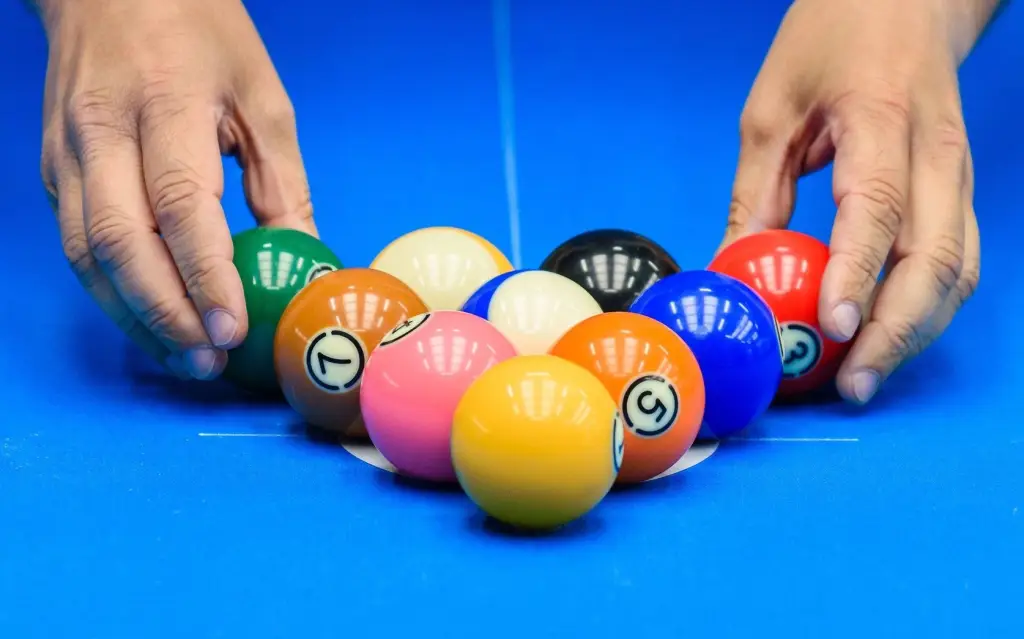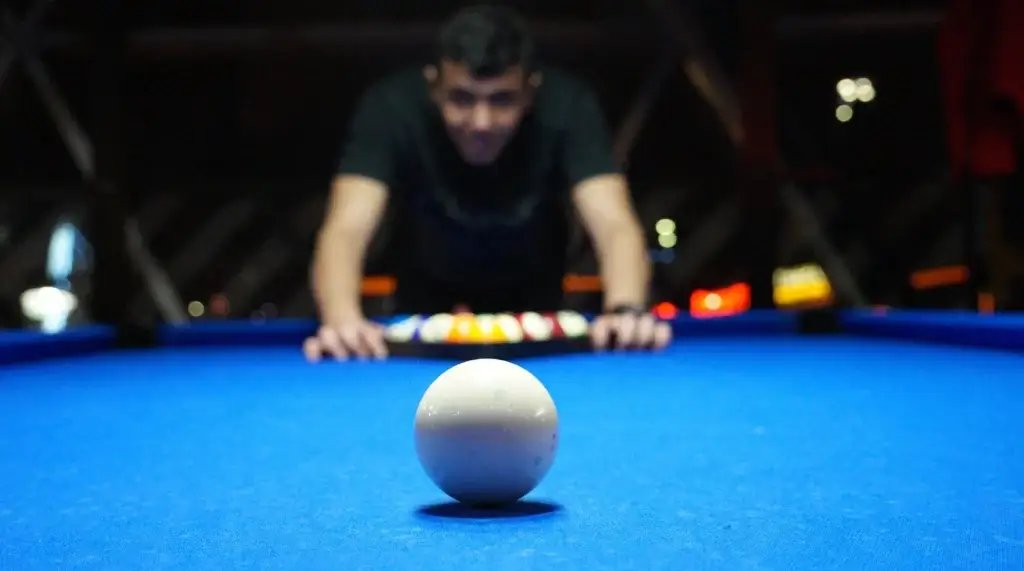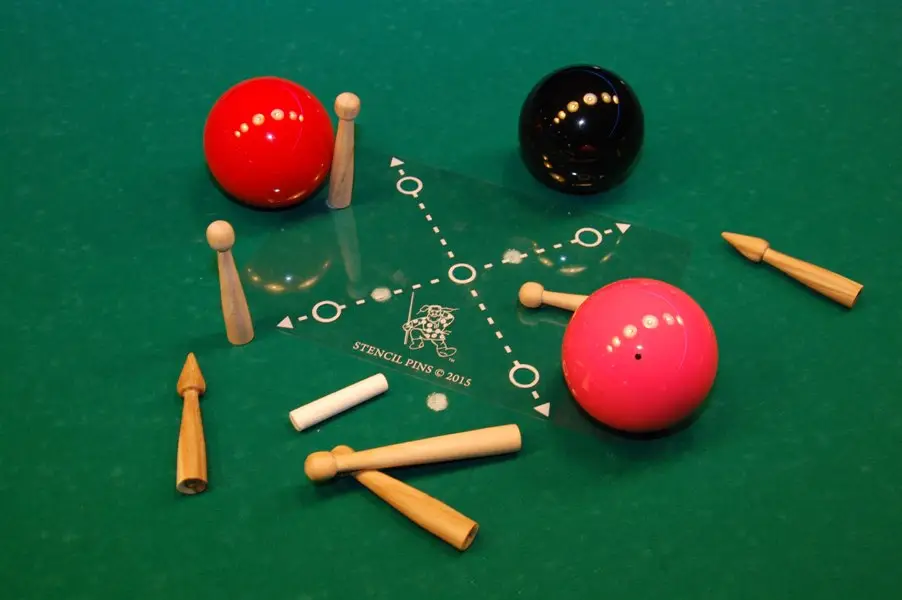Billiards is an exciting game that combines skill, precision and strategic thinking. It doesn’t matter if you are new to holding a cue or already have experience: understanding the main rules and effective tactics is the key to successful play. This article is your guide to the world of sports: we will explain in detail how to play American pool.
Equipment and terminology
A standard pool table is 274 x 137 cm in size. The surface of the lining provides uniform friction, the sides give a return coefficient of up to 0.9. The balls weigh about 170 g, diameter – 57 mm. The cue is made of maple or composite and is 147 cm long. The holes have a bevel and a diameter with a tolerance that allows a ball to pass through with a clearance of 2-3 mm.
To understand how to play American pool, it is necessary to know the basic concepts: a stroke with the hand, after a foul; personalized – target and pocket advertising; error – an error in the technique or the rules; stalemate – a draw because it is not possible to play; The black ball is the last ball in group 8; roll – first hit from a triangle; combination – playing through another ball.
How to play American pool: rules and formats
 The game is played with a set of 16 balls: 15 numbered balls and one cue ball. There are several popular formats. The rules of each mode determine their own tactics:
The game is played with a set of 16 balls: 15 numbered balls and one cue ball. There are several popular formats. The rules of each mode determine their own tactics:
- The Pool 8 format consists of two pools: plain (1-7) and striped (9-15). The player must first pot all the balls in his group, then the black (8th). A wrong move by black results in an early loss.
- In 9-ball pool, you must pot balls 1 through 9 in the correct order. The player gets the lowest number on the table, but can pot any ball with a combination. A successful piece on the 9th brings victory. The rules of billiards include: fouls for hitting the wrong ball, not hitting the cushion after a shot, the cue ball falling into a pocket, and the ball going off the table. In case of repeated fouls, the opponent takes his turn and may receive a shot.
Match algorithm: logic, purpose, implementation
Each game begins with building the pyramid (triangle) and throwing the throw. A successful result is one ball played, or at least four balls scattered along the sides. Then the player performs a series of attacks aimed at the allowed group. Displacement – one attempt. A pot ball is a continuation. A foul is a change in movement.

To learn how to play American pool, it is important to follow the following principles:
- Control of the cue ball: direction, bounce, stop.
- Calculation of the angle of attack and side return.
- Evaluate the position of the next shot before performing the current shot. Minimize impact force while maintaining accuracy.
- Know the risk zones: potential breakage, pinching, pocket closure.
American Pool strategies: how to play regularly and win
Tactics play a key role. Intuition only works in combination with technical skills. An experienced player limits risks and provokes mistakes from his opponent. To understand strategies, it is necessary to take into account the position of each ball, the possible development scenario, the combination possibilities and the completion zone.
Control of a table begins with the selection of groups. After the player has potted the first ball, he gets his half back. It is important to assess which group has the best position. The strategist quickly clears the important balls and brings the cue ball to the center. At the end of the movement, leave the position for the next shot: it is the positional play that determines the winner.

Beginner mistakes: acting blindly, using force instead of precision, ignoring commands, ignoring the throw. An advanced player calculates the consequences well: if the ball falls, where will the cue ball end up? Will the next square open? Will the opponent be able to take a comfortable position?
Ordered strikes and their role in the battle for positions
Some modes require an order (giving up a ball and a pocket before execution). This is not a formality. This approach shows that you have the situation under control and eliminate risks. Trust is important: any mistake leads to loss of the game. The player uses the order to extend the series. By getting the ball into the designated pocket, you gain a moral advantage and control over the situation. If you do not place an order, you run the risk of disputes, especially in tournaments and when playing for points. It is the personal stroke that, if executed correctly, allows you to play American pool at a professional level. This is a sign of a systematic approach, not improvisation.
When the rule is a weapon: foul, putt and punch
A foul occurs when there is a mistake in the shot, but also when the sequence of the shot is not correct, the balls are touched, there is too much thought (the timer) or the shot is repeated. The opponent gets the ball out of his hand and can put it anywhere on the table. This is the critical moment: a foul leads to loss of control.
A stalemate is a draw when the same position is repeated several times, the opponent cannot complete the position or when there are mutual ‘withdrawing’ tactics. This rarely happens, but it has an impact on the structure of the tournament. Understanding fouls and draws is essential when learning the rules of American pool: these nuances determine the outcome.
American billiards from the perspective of a beginner
The beginner overestimates the power and underestimates the course. The urge to “score at all costs” leads to a loss of position. Progress begins with determining your stance, adjusting your sights and refining your grip. By analyzing your own mistakes and consistently working on solutions, you build confidence.
Recommendations for beginners include:
- Attack without haste.
- Control force and torque.
- Use chalk for stabilization.
- Read sideways: the angle of attack is equal to the angle of rebound.
- Be aware of the importance of every detail of the action.
How to play American Pool: Conclusions
 American billiards develops logic, motor skills and reaction time. It is not the strongest who wins, but the most accurate and calculating. Strategy, knowledge of the rules of pool, control of the cue ball and positional play form the basis for success. Learning to play pool is done by making smart shots, adapting to the situation and constantly developing your accuracy. Every ball is a solution, every move is a sequence. The game teaches you to see, think and win.
American billiards develops logic, motor skills and reaction time. It is not the strongest who wins, but the most accurate and calculating. Strategy, knowledge of the rules of pool, control of the cue ball and positional play form the basis for success. Learning to play pool is done by making smart shots, adapting to the situation and constantly developing your accuracy. Every ball is a solution, every move is a sequence. The game teaches you to see, think and win.
 en
en  ru
ru  de
de  ar
ar  es
es  nl
nl  hi
hi  fr
fr  it
it  pt
pt  el
el 


